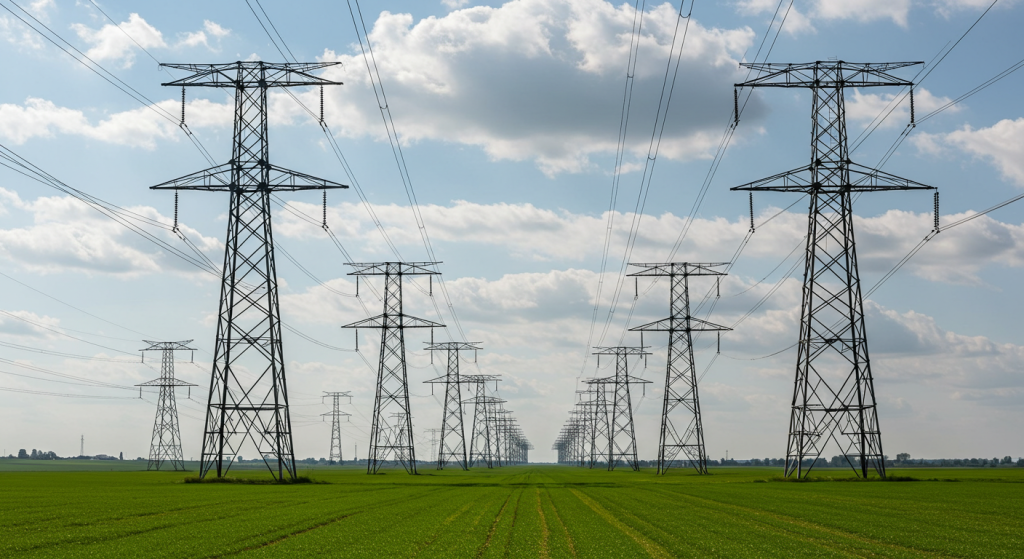Energy Transmission Towers: Powering Our Modern World
2025-04-19
What are Energy Transmission Towers?
Energy Transmission towers, also known as electricity pylons or power transmission towers, are structures specifically built to support overhead power lines. These lines transport electricity to substations and further, where it is used by the consumers. They are designed to ensure continuous energy flow and power usage by withstanding environmental stresses like strong winds, heavy snow, and ice loads.
An Introduction to Energy Transmission Poles
Energy transmission poles work directly with the power frameworks; therefore, they are more active when compared with their counterparts. These poles are vertical structures armored against extreme weather and help with the suspension for the electric power distribution systems.
Types of Energy Transmission Poles
Energy transmission poles can be manufactured of various materials like steel, wood, and concrete. Steel poles are most often used in high-voltage transmission towers because of their strength and durability. Wooden poles are used in less populated rural areas with low voltage distribution systems, and concrete poles are best used in areas with harsher weather.
- Function and Design
These structures are custom-made for supporting important equipment like power lines. The design of power transmission poles changes by function, voltage level, and even geographical location. Some poles are designed for single circuit line or double circuit line suspension, while others serve specific functions, like tension towers and suspension towers.
- Significance in Power Distribution
Energy transmission poles are the basic building blocks of the entire electric conductivity grid that zig-zag from power plants to houses and places of work, hundreds of kilometers apart. These components need to be extremely robust and dependable in order to ensure the overall integrity and safety of the grid.
Function and Purpose of Transmission Towers
Towers that belong to the overhead power transmission line are referred to as transmission towers. In the context of electric grids, transmission towers are of various types and cater to different functions. Each one of these structures is divided into groups depending on the functions executed by the groups in the transmission system.
1. Suspension Towers
Also called tangent towers, suspension towers are meant for supporting transmission lines that do not require turning. These towers occur mostly in the straight parts of the power lines.
2. Tension Towers
Also referred to as angle towers, tension towers are a means of supporting power lines that are at sharp angles. These towers relieve the additional stress created when there are changes in direction.
3. Dead-End Towers
Dead-end towers or terminal towers are found at the last substation for a transmission line. These towers receive all the tension of the power lines.
4. Transposition Towers
Transposition towers carry out the rearrangement of power lines to equal the flow of electrical current. These towers are crucial in the system of AC electricity transmission of high voltages.

Key Components of Transmission Towers
The design of Energy transmission towers involves a range of factors that impact the overall effectiveness and lifespan of the transmission structure. These components include:
1. Insulators
Insulators prevent current from flowing through the vertical structure of a tower and ensure that the current takes the intended route via the power lines. This is done by defeating porcelain or composite polymer materials.
2. Crossarms
Crossarms are members rigidly fixed at the uppermost section of the tower, also called the head of the tower. Aside from holding the power lines in place, they are capable of allowing a balanced distribution of electric power and stress toward the tower.
3. Conductors
Materials that transmit electricity are called Conductors. Due to its low weight and ability to transmit electricity over long distances, Aluminum is commonly used.
4. Stockbridge Dampers
Wind causes the oscillation of transmission lines, and this is controlled using dampers for Stockbridge. These dampers serve the purpose of protecting the power lines and the towers from damage.
How to Maintain Transmission Towers?
It is critical to carry out preventive maintenance to ensure the reliability of the energy grid when it comes to transmission towers. Aloft, the towers and power lines are prone to suffering from corrosion, wear and tear, and weather damage.
1. Corrosion and Wear
Coastal areas are especially prone to humid salt, causing steel towers to corrode. Dismantling corrosion causes damage to the steel tower and additional issues like wear and tear. Scrub mountains undergoing routine inspections would require paint touch-ups.
2. Environmental Impact
The activities of constructing and maintaining towers transmit and have devastating effects on the environment. Location would consider the most seldom used building towers require special attention to mitigate destruction to wildlife.
3. Safety Protocols
The main hazard is the high voltage transmitted through the power lines of the transmission towers. Every possible measure needs to be taken to ensure the no-touch policy when it comes to dealing with the plate, maintenance, and repairs of the towers.
Benefits of High Voltage Transmission
Long-distance transfer of electricity is made possible by high-voltage power transmission. Energy loss should be kept to a minimum during transmission, and high-voltage power lines must be lifted and suspended at levels of 110 kV (kilovolts) or even higher for optimal energy transfer over long distances. Transmission towers are a part of the infrastructure. Power transmission systems can be subdivided into two categories:
1. HVAC (High Voltage Alternating Current)
HVAC is the most practiced method of power transmission. As most of the transmission towers keep AC electricity, the grid has AC electricity being passed through, as is the case with the majority of the substations.
2. HVDC (High Voltage Direct Current)
For long-distance power transmission, HVDC is reserved. Substation towers relying on alternating current, also known as HVDC systems, must be used in place of traditional ones using direct current electricity.
Conclusion
Today, energy transmission towers are crucial for maintaining the lifestyle modern society enjoys. They are constructed to transmit electricity at very high voltages over long distances to serve residential, industrial, and commercial needs. As a vertically integrated manufacturer, XY Tower designs, builds, and maintains steel lattice towers and other new renewable energy transmission solutions. We have the know-how and technology to assist you. Learn more about our offerings here.

Hey, I’m Chunjian Shu
"X.Y. Tower: Reliable, innovative solutions for high-quality towers and electrical equipment with professional service.
